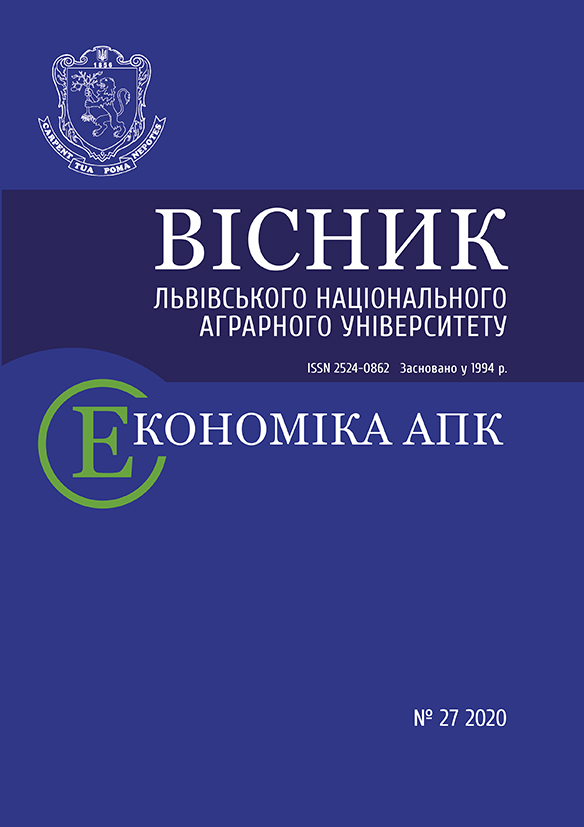Visnyk LNAU: Agronomy 2021 №25: 34-39
INTENSITY OF THE PROCESSES OF THE ORGANIC XENOBIOTICS TRANSFORMATION IN SOIL
Ivankiv M., Candidate of Agricultural Sciences
ORCID ID: 0000-0002-4911-2877
Kachmar N., Candidate of Agricultural Sciences
ORCID ID: 0000-0003-4471-5895
Datsko T., Candidate of Agricultural Sciences
ORCID ID: 0000-0002-2957-1822
Dydiv A., Candidate of Agricultural Sciences
ORCID ID: 0000-0002-4436-9008
Pavkovych S., Candidate of Agricultural Sciences
ORCID ID: 0000-0002-0844-3071
Balkovskyi V., Candidate of Agricultural Sciences
ORCID ID: 0000-0002-3995-1909
Lviv National Agrarian University
https://doi.org/10.31734/agronomy2021.01.034
Annotation
The use of various agrochemicals in agriculture is an integral part of modern technologies for growing crops. Therefore, their long-term use in vast areas has led to large-scale pollution.
The results of our research show that the soils of the surveyed fields in the model areas contain pesticides in different amounts and create a certain background of pollution. However, in the vast majority of the studied samples, the level of their content does not exceed the maximum allowable concentration. At a distance from the warehouse, we observe a gradual decrease in the content of pesticides, and at a distance of 50 m from the warehouse in the arable soil layer exceedances of the MPC at the studied points and soil, horizons are not observed.
Environmental pollution by persistent pesticides and their metabolites is one of the most negative factors affecting soil quality. Locally contaminated areas adjacent to the sanitary protection zones of pesticides are the territories with certain areas of high concentration of substances that degrade soil quality.
To obtain reliable data on the regularity of distribution and peculiarities of migration of organochlorine pesticides and their isomers in soils, it is necessary to study the natural environment as a whole, at all levels of the organization. The task of the urgent organization of agri-environmental monitoring in the areas that have reached a critical state becomes clear. Therefore, to detect chemically degraded and contaminated soils, an agroecological assessment of soil contamination with residual amounts of organochlorine pesticides, namely HCH and its isomers (α-HCH; β-HCH; γ-HCH) was performed within the sanitary zone.
Studies on dark gray podzolic soil in the Western Forest-Steppe of Ukraine, within the sanitary protection zone of inactive warehouses of agrochemicals in the village of Hlynsko and the village of Viazova, Zhovkva district, Lviv region, it has been established that the process of HCH and self-purification of soils from xenobiotics is active. It was found that the pollution is spotty, due to the peculiarities of the operation of the studied area in the past.
Key words
organochlorine pesticides, dark gray podzolized soils, accumulation, transformation, pollution soil
Link
- Voitsikhovska A. S., Shybanova A. M., Chapovska R. B., Malovanyi M. R. Use of environmentally friendly pesticides in agriculture. Sugar of Ukraine. 2017. No. 8 (140). Р. 45–48. URL: http://nbuv.gov.ua/UJRN/Cu_2017_8_6 (Last accessed: 10.03.2021).
- Iutynska H. O. Yamborko N. A., Pindrus A. A. Investigation of mutagenic activity of hexachlorocyclohexane and products of its microbial degradation. Microbiological Journal. 2010. Т. 72, No. 6. P. 18–22. URL: http://nbuv.gov.ua/UJRN/MicroBiol_2010_72_6_4 (Last accessed: 10.03.2021).
- Microbial destruction of chlorine-organic cyclic hydrocarbons derivatives in the soil / G. O. Iutynska et al. Scientific reports of the National Agrarian University: Agronomy. 2007. No. 1(6). https://nd.nubip.edu.ua/2007-1/07igoits.pdf (Last accessed: 11.03.2021).
- Guidelines for the determination of microquantities of pesticides in food, feed, and the environment. No. 42. Official publication. Kyiv, 2005. 246 p.
- Methodical recommendations for a comprehensive assessment of the degree of chemical degradation of soils / O. I. Furdychko and others. Kyiv: Ministry of Agriculture, 2010. 35 p.
- Methods for determination of trace amounts of pesticides in food, feed and the environment: a reference book. Vol. 1–2 / Comp. M. A. Klisenko and others. Moscow: Kolos, 1992. P. 11.
- Mokliachuk L. I., Lishchuk A. M., Horodiska I. M. and other. Contamination of soils with resistant pesticides and their remediation. The problem of chemical soil degradation in the context of sustainable development of agroecosystems. Ukrainian farmer's manual. 2011. P. 105–112.
- Systematic analysis of multicomponent pesticide pollution of the main types of soils of Ukraine: methodical recommendations. / O. I. Furdychko and others. Kyiv: Ministry of Agriculture, 2010. 30 p.
- Sukhoparova V. P., Strekozov B. P., Perfilova N. V. Degradation and distribution forms of HCH and arylamide pesticides in three types of soils. Agrochemistry. 1990. No. 3. P. 107–113.
- Chemical oxidation and reduction of hexachlorocyclohexanes: Wacławek S. et. al. A review Water Research. 2019. No. 162. Р. 302–319. URL: https://doi.org/10.1016/j.watres.2019.06.072 (Last accessed: 10.03.2021).
- Muhammad Zaffar Н., Vivek К., Ajit V. Xenobiotics in the Soil Environment: Monitoring, Toxicity and Management. Cham, Switzerland: Springer, 2017. URL: https://doi.org/10.1007/978-3-319-47744-2 (Last accessed: 10.03.2021).
- Persistent Organic Pollutants in Food: Contamination Sources, Health Effects and Detection Methods / Guo W. et al. Int. J. Environ. Res. Public Health, 2019. 16 (22). P. 4361.
- Reductive dechlorination of hexachlorocyclohexane (HCH) isomers in soil under anaerobic conditions / P. J. M. Middeldorp et al. Biodegradation. 2005 Jun;16 (3). P. 283–290.
- Remediation of soil contaminated by lindane wastes using alkaline activated persulfate: Kinetic model. Garcia-Cervilla R. et al. Chemical Engineering Journal. 2020, 393. P. 124–646. URL: https://doi.org/10.1016/j.cej.2020.124646 (Last accessed: 10.03.2021).
- Santos López A., Dominguez Torre C.-M. and David Lorenzo Fernandez HCH-Contaminated Soils and Remediation Technologies. August, 2020.
- Silvani L., Cornelissen G., Hale S.-E. Sorption of α-, β-, γ- and δ-hexachlorocyclohexane isomers to three widely different biochars: Sorption mechanisms and application. Chemosphere. Vol. 219, March 2019, P. 1044–1051. URL: https://doi.org/10.1016/j.chemosphere.2018.12.070 (Last accessed: 10.03.2021).



